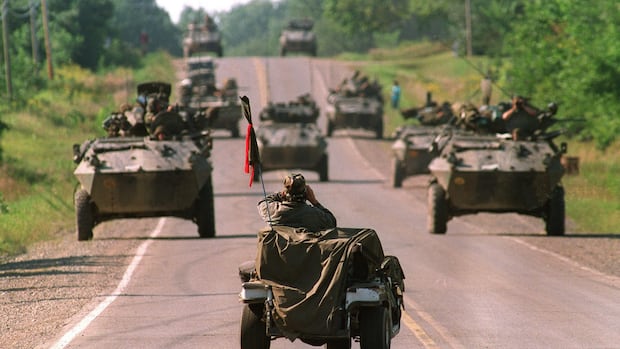Katsi’tsakwas Ellen Gabriel says she was sitting in the Japanese consulate in Montreal when she started to learn how far Canada’s spies can reach. It was two years after Gabriel was the Kanien’kehá:ka (Mohawk) spokesperson during the military’s 1990 siege of Kanehsatà:ke and Kahnawà:ke, commonly called the Oka Crisis. That summer, a botched police raid on a small blockade ignited a tense 78-day armed standoff, as activists fought to stop a golf course expansion from desecrating a cemetery at Kanehsatà:ke, near Oka, Que.In 1992, Gabriel was invited to an Indigenous conference in Japan and planned to travel on a Haudenosaunee Confederacy-issued passport. But she couldn’t get a visa, so she went for a meeting to find out why. That’s when she says a Japanese official pulled out a dossier on her as thick as a novel, telling her it was compiled by the Canadian Security Intelligence Service (CSIS).“He said, ‘You’re going to go to Japan and you’re going to shame our ally Canada, our friend Canada’,” Gabriel told CBC Indigenous. “And so they wouldn’t give it to me.”Katsi’tsakwas Ellen Gabriel speaks to the media in the summer of 1990. She was chosen by the People of the Longhouse and her community of Kanehsatà:ke to be their spokesperson during the ‘Oka Crisis,’ a 78-day standoff to protect ancestral Kanien’kéha:ka (Mohawk) land in Quebec. (The Canadian Press)Indigenous rights activists have long accepted that surveillance by the state is the price to pay for asserting their sovereignty.Now, recently declassified documents confirm CSIS subjected Indigenous activists to a series of “Native extremism” investigations for at least a decade beginning in 1988, in a countrywide surveillance program that became more intrusive following the resistance at Kanehsatà:ke.The investigations are confirmed in about 1,000 pages of previously secret internal papers from CSIS and its review body dated from 1988 to 1999, released to CBC Indigenous over about three years via four formal access to information requests and one informal request for records already released.“Consistently, in all of these reports, ‘Native extremism’ is identified as a leading priority,” said Jeffrey Monaghan, an associate professor of criminology at Carleton University in Ottawa.Through the 1990s, “Native extremism” was categorized under the umbrella of “domestic terrorism” or “domestic extremism,” the papers show. The latter was one of CSIS’s four broad categories of “terrorist groupings.”“The language that CSIS used in this document fundamentally delegitimizes the rights of Indigenous people. I think it’s fair to claim that a lot of this language itself is racist. It’s highly colonial,” said Monaghan.Vibert Jack, litigation director at the B.C. Civil Liberties Association, expressed similar concerns.“The biggest issue that stands out is just the overreach of CSIS, and tied to that is the systemic racism that this so-called ‘Native extremism’ program of theirs demonstrates,” he said.In Gabriel’s case, she was eventually permitted to travel to Japan on a Canadian passport, but the problems didn’t stop. She says she was detained, filmed and searched on arrival. “You know, CSIS has a long arm,” she said.Snooping on Innu NationNow rewind a few years.On Dec. 12, 1988, Bob Bartel, a worker with the Mennonite Central Committee (MCC), was relaxing at home in Happy Valley-Goose Bay in central Labrador when he got a call from someone claiming to be from the solicitor general’s office. The caller, Roy Kearley, wanted to discuss the Innu — now. Through the MCC, a global Christian non-profit organization, Bartel was helping Innu Nation peacefully protest against NATO fighter jets conducting low-level training flights over their hunting grounds. WATCH | Innu protest low-level flights:Innu speak out against low-flying jetsStudy conducted on impact of NATO training base in Goose Bay, Newfoundland.Beginning in 1984, the military alliance of Western states would send jets shrieking through the sky with an ear-splitting boom, spooking the caribou herds and terrifying people. In response, Innu protesters occupied the airfield at the military base at Goose Bay. Bartel was initially concerned but made some quick calls and got permission to take the meeting. He proceeded to the mysterious caller’s suite at the Labrador Inn. “At that point, he identified himself as a member of CSIS, which kind of floored me a bit because I was a little bit — I don’t like the spy agency,” Bartel said.The CSIS officer began with simple questions but soon turned to the agency’s true interest: whether the Innu were being influenced by communist countries in eastern Europe.“I told him that the only foreign manipulation I knew of was the manipulation of the town council by the NATO commanding forces,” Bartel said.“So that basically ended the conversation.”But it didn’t end the snooping. Two days later, CSIS opened what appears to be its first “Native extremism” investigation since the agency’s inception in 1984. The probe was billed internally as unintrusive and limited and was closed after just three months. CSIS concluded “unplanned sporadic violence” was possible but “there was no reason to believe that there would be any organized attempt to initiate violence across the country in a pattern that could give rise to a reasonable suspicion of a threat to national security,” says one report.CSIS decides activities ‘had become political’Soon CSIS’s watchdog agency was investigating, too.The Security Intelligence Review Committee (SIRC), a now-dissolved external body, scolded CSIS for its treatment of Bartel in a November 1989 classified report, which found Kearley acted without authorization and breached regulations. The review body was also concerned the subsequent probe “cast the net too broadly.”“We are struck by the fact that most activities listed were either peaceful protest, or were civil disobedience,” SIRC observed. We are struck by the fact that most activities listed were either peaceful protest, or were civil disobedience.- Security Intelligence Review Committee, 1989.Ultimately, however, SIRC found the investigation was justified, more like an academic study than a spy probe. The watchdog followed that with another secret report on CSIS activities involving Indigenous people in 1991. Both were released to CBC Indigenous in 2023.This second report shows CSIS produced at least 16 threat assessments about Indigenous peoples between March 1989 and July 1990, before officially reopening the investigation as a direct response to the standoff at Kanehsatà:ke.Up to that point, CSIS officials saw the unrest and violence rocking a few First Nations communities as “essentially criminal” in nature, thus an issue for the police rather than the security service, but Kanehsatà:ke changed their views.“CSIS HQ decided Native activities had become ‘political’ and a level two targeting authorization was sought to ascertain the nature of violence associated with aboriginal land claims disputes,” SIRC reported on Jan. 30, 1991.A level two CSIS investigation allowed the interview of the target or any other person, physical surveillance as well as other tactics that were censored from the documents.WATCH | Army dismantles barricades in 1990:Canadian army intervenes at OkaThe Canadian army takes down the blockades. Aired Sept. 1, 1990 on CBC’s The National.Ward Elcock, who was security and intelligence co-ordinator at the Privy Council Office at this time and CSIS director from 1994 to 2004, said no one should be surprised the service was looking at these issues.“From the point of view of an organization like CSIS, you have to remember what we’ve gone through at Kanehsatà:ke and Kahnawà:ke,” Elcock told CBC Indigenous this summer.“Groups in Canada armed with M60 machine guns and .50 calibre sniper rifles and rumoured other fairly heavy weaponry causes a fair amount of concern. There was a concern about violence and it’s clear from the CSIS Act that where people seek to advance political causes by violence, they can be subject to investigation.”To justify military operations, the authorities repeatedly relied on sometimes unconfirmed or rumoured reports of the Mohawk Warrior Society potentially having things like machine guns and even rocket launchers.The RCMP, however, noted “none of the exotic weapons the Warriors were alleged to possess” were recovered, save for a Barrett .50 calibre Model 82A1 semi-automatic sniper rifle seized from the Longhouse in Kahnawà:ke near Montreal, documents say.A heavily censored page from a declassified CSIS annual report calls the 1995 conflict at Ipperwash Provincial Park an example of extremists using armed standoff to achieve a political goal. A public inquiry later found the activists had no guns. (Canadian Security Intelligence Service)In a statement, CSIS said it cannot confirm or deny specifics of these operations beyond what was released publicly.“Since its creation in 1984, CSIS has not based its investigations on specific communities. Rather, CSIS investigates ideologically, religiously, and politically motivated violent extremism,” the statement reads.“All CSIS activities comply with Canadian law and ministerial direction. Freedom of speech is constitutionally protected. That said, CSIS may raise concerns should a threat actor rise to the threshold when the activities are directed toward or support the threat of serious violence.”Not everyone agrees there was any real national security threat, however.“I’m shocked that we’re that frightening to these people,” said Kahentinetha Horn, a lifelong Indigenous rights activist from Kahnawà:ke. Horn travelled to Kanehsatà:ke during the 1990 standoff. She told CBC Indigenous she questions the justification for these investigations and believes the goal was intimidation and repression, “to take our fighting spirit out of us so that we will be afraid.”“We’re talking about in 1990, they sent the entire military here, put us in military barracks and treated us really badly,” she continued.“We came through all that — and this is men, women and even some children — and they even stabbed my daughter and almost killed her.”Surveillance ramps upCSIS went on to intensify this surveillance.In March 1991, the Progressive Conservative federal government approved CSIS’s plan to investigate the potential for violence associated with Indigenous issues, according to that year’s top secret annual CSIS report.Consequently CSIS “increased both the scope and the intrusiveness” of the probe, targeting the Mohawk Warrior Society and “similar groups with the potential for acts of serious violence,” the report says. The solicitor general also offered “special instructions” allowing CSIS to exercise “its full range of investigative techniques within law and policy.”While depicted by CSIS as a “renegade” and “paramilitary” group, the Mohawk Warrior Society was organized loosely, composed of traditionalist men who felt defence of their nation was their duty. It became known for resisting police incursions on Kanien’kehá:ka territories.In an undated CSIS report titled “Managing the Oka Aftermath,” Gabriel is personally named as a “known faction” in Kanehsatà:ke. The report warned of “future hostilities” stemming from root political and economic issues. Gabriel, however, called the report skewed and inaccurate.During this era, she knew she was being watched. “I didn’t have any suspicions: It was confirmed. My mail was opened. I received these notices that I was being surveilled,” she said.CSIS went on to monitor potential flashpoints from coast to coast — from the Gitxsan and Wet’suwet’en land claim in northern British Columbia to the Innu of Labrador and their struggle with NATO — according to a national overview from 1991.University of Victoria law professor David Milward said he finds it offensive for CSIS to liken Indigenous rights-based activism to terrorism.“There’s a clear dividing line between activities that might be criminal under Canadian law, like for example a violent encounter with police, and actual terrorist activity, like for example sending a suicide bomber into civilian territory,” he told CBC Indigenous.Milward said much of what he read in the files was “speculative fearmongering,” or self-justification.“It almost had a chasing-a-ghost kind of feel to it,” he said.Ipperwash, Gustafen Lake and beyondWhether or not they were chasing a ghost, the investigations continued.CSIS was actively investigating and had extensive interest in major land disputes in 1995 at Ipperwash in Ontario and Gustafsen Lake in B.C., CBC Indigenous previously revealed.CSIS still saw the Mohawk Warrior Society as a potential threat as late as 1997, warning the society remained “committed to the defence of its interests.”In 1998, this program continued under the Liberal government, which directed CSIS to pursue “sensitive domestic issues” that included Indigenous activism. The spies still feared conflict could ignite anywhere.“Unresolved grievances within Canada’s Native communities related to land claims, resource development, fishing rights, self-government, taxation, policing and health care continue to provide conditions ripe for confrontation of varying levels of intensity and violence,” reads a counter terrorism branch report dated 1998-99.WATCH | CSIS investigated ‘Native extremism’ at Ipperwash:CSIS documents give insight into 1995 Ipperwash fatal shootingNewly declassified documents obtained by CBC Indigenous show CSIS was actively investigating what it called “Native extremism” at Ipperwash weeks before Dudley George was shot and killed by OPP in 1995.This report is heavily redacted but a reference to a “network of directed sources, protected contacts and police liaison” offers insight into some likely tactics.In other words, a decade after Bob Bartel was interviewed about foreign interference in Labrador, CSIS’s “Native extremism” program had evolved into a counter-terror project keeping tabs on legitimate Indigenous political grievances.Gabriel said she’s tried to get her file but was met with CSIS’s standard response — that it can neither confirm nor deny the records exist.
Tuesday, 18 Nov 2025
Canada – The Illusion
Search
Have an existing account?
Sign In
© 2022 Foxiz News Network. Ruby Design Company. All Rights Reserved.
You May also Like
- More News:
- history
- Standing Bear Network
- John Gonzalez
- ᐊᔭᐦᑊ ayahp — It happened
- Creation
- Beneath the Water
- Olympic gold medal
- Jim Thorpe
- type O blood
- the bringer of life
- Raven
- Wás’agi
- NoiseCat
- 'Sugarcane'
- The rivers still sing
- ᑲᓂᐸᐏᐟ ᒪᐢᑿ
- ᐅᑳᐤ okâw — We remember
- ᐊᓂᓈᐯᐃᐧᐣ aninâpêwin — Truth
- This is what it means to be human.
- Nokoma












